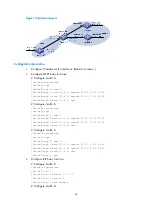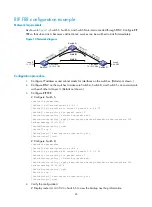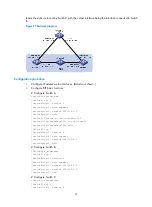
54
Configuring OSPF
Hardware compatibility
The A5500 SI Switch Series does not support OSPF.
Overview
Open Shortest Path First (OSPF) is a link state interior gateway protocol developed by the OSPF working
group of the IETF. Now, OSPF version 2 (RFC 2328) is used. Unless otherwise noted, OSPF refers to
OSPFv2 throughout this chapter. The term "router" in this chapter refers to both routers and Layer 3
switches.
OSPF has the following features:
•
Wide scope
—Supports various network sizes and up to several hundred routers in an OSPF routing
domain.
•
Fast convergence
—Transmits routing updates instantly upon network topology changes.
•
Loop-free
—Computes routes with the shortest path first (SPF) algorithm to avoid routing loops.
•
Area-based network partition
—Splits an AS into different areas to facilitate management. In
addition, routing information transmitted between areas is summarized to reduce traffic and routing
table sizes.
•
Equal-cost multi-path (ECMP) routing
—Supports multiple equal-cost routes to a destination.
•
Routing hierarchy
—Supports a four-level routing hierarchy that prioritizes routes into intra-area,
inter-area, external Type-1, and external Type-2 routes.
•
Authentication
—Supports area- and interface-based packet authentication to ensure the security of
packet exchange.
•
Support for multicast
—Multicasts protocol packets on some types of links.
Basic concepts
Autonomous System
An Autonomous System (AS) comprises a group of routers that run the same routing protocol.
OSPF route computation
OSPF computes routes in an area as follows:
•
Based on the network topology around itself, each router generates Link State Advertisements (LSAs)
and sends them to other routers in update packets.
•
Each OSPF router collects LSAs from other routers to compose a link state database (LSDB). An LSA
describes the network topology around a router, and the LSDB describes the entire network
topology of the AS.
•
Each router transforms the LSDB in the area to a weighted directed graph, which is the topology of
the entire network. All the routers of the area have the same graph.
















































